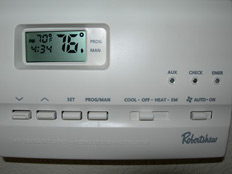Campus News
March 25, 2011
Setting temperatures will save energy

During the cooling season, temperatures will be set at 76°.
Starting July 1, Emory will implement a new plan to manage temperature settings in its office spaces and public and common areas in most campus buildings. Exceptions will be Emory clinics, research, special use (i.e., Manuscript Archives Rare Book Library) and lab buildings.
One of Emory’s goals in its strategic vision is to reduce overall energy consumption by 25 percent per square foot by 2015. A significant way to accomplish this is to stabilize temperature set points throughout campus buildings.
Supported and encouraged by University leadership, this joint effort is led by Campus Services and the Office of Sustainability Initiatives to implement a set temperature policy across the University.
The University-wide policy is planned to set temperature points in the following way:
• During the cooling season, temperatures will be set at 76° (+/- 2°); and relative humidity no more than 60 percent.
• During the heating season, temperatures will be set at 68° (+/- 2°).
If you feel your area is outside these temperatures (below 66 ° in the winter or above 78° in the summer), call the zone shop supervisor or Customer Service Center at 404.727.7464.
These calls will be made a priority and that building’s area temperature settings will be examined by a Campus Services technician.
Space heaters and open windows often cause a false reading for HVAC control systems and will adversely affect the surrounding area. Building occupants should make sure open windows are closed and space heaters are removed.
In a recent energy reduction effort, Emory turned down thermostats over two four-day periods during the holidays to reduce energy costs. In addition to saving approximately $30,000, Emory:
• Saved as much energy as used by 24 typical American houses for one year (12,733kWh/house/year); and
• Reduced emissions of CO2 equivalent to taking 57 vehicles off the road for a year (11,260lb CO2/vehicle/year).
